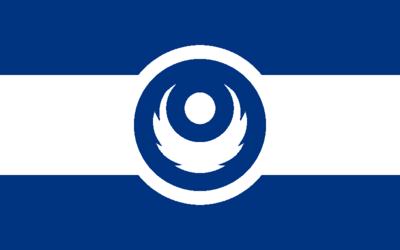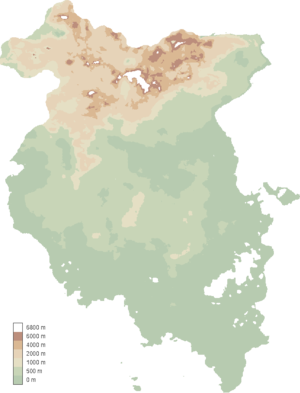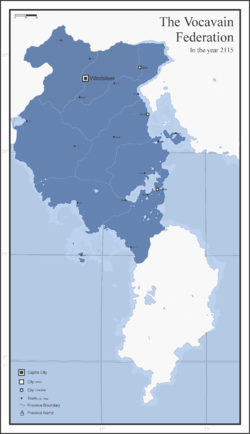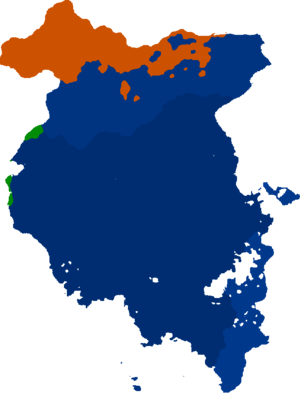Vocavium
|
Vocavian Federation
Caelum Tonitr
|
|||||
|---|---|---|---|---|---|
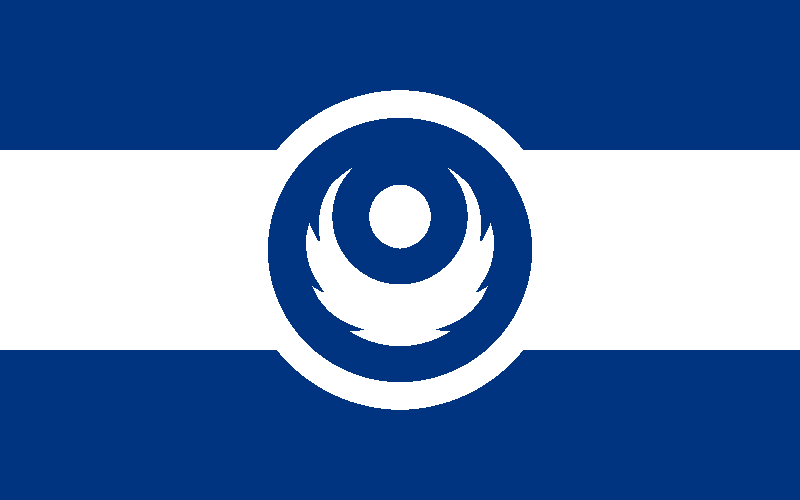 |
|||||
| Motto | "Frede en Tonger" (Peace and Thunder) | ||||
| Common Name | Vocavium | ||||
| Anthem | "The Drums of Avem" | ||||
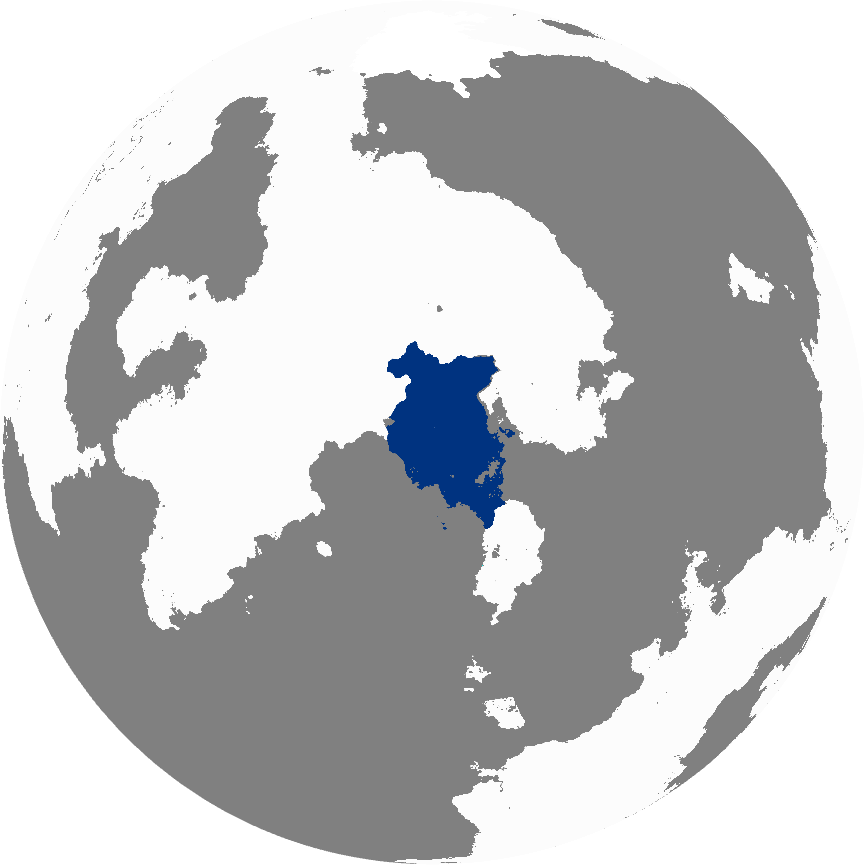 |
|||||
| Demonym | Vocavian | ||||
| Official languages | Vocavian, Krostanian | ||||
| Currency | Solvit | ||||
| Politics | |||||
| Capital | Windsteer | ||||
| Government | Federal semi-direct presidential republic | ||||
| Foundation | 2080 | ||||
| Preceded by | Eureka | ||||
| Demography | |||||
| Ethnicities | 81% Vocavian 10.5% Strelkan 5% Krakenary 2% Kostel 1.5% Other |
||||
| Population | 11,710,013 | ||||
| Area | 30,182km^2 km² | ||||
Etymology
###
Geography
Vocavium is a nation situated on the Westray Peninsula. It borders the Republic of Krome to the west, Greater Kardania to the north east, and Westray to the east.
Vocavium is characterised by it's preponderance of mountains, for which the Vocavian people have a natural affinity. The Avem mountain range dominates most of the northern landscape, hosting exceptionally steep and craggy peaks that are near impossible to navigate. This inhibits movement throughout the territory, though also serves as an impregnable defence against invading armies. The tallest peak within Vocavium is Mt. Ataksak, with an elevation of 6,038m. It is directly east of the capital and serves as a natural defence against invaders, with almost completely sheer cliff faces. Much of Vocavium is situated at high altitude, resulting in low annual temperatures and significantly reduced atmospheric pressure. As such, much of the northern territory is frigid and not conducive to fertile land. However, south of the Avem mountains the land is situated at much lower elevations, giving rise to rolling meadows and fertile soils. At the southern border with Floracia, meadows are interspersed with tropical marshes and mangrove forests.
The K'yangtze river runs to the east of Vocavium and acts as a natural border with Strelka, Karland and Westray. It's source is located to the northern-most region of Vocavium's mountain ranges and is fed by melt-water from glaciers and snow. The mouth of the river opens into a bay containing the East River Islands, a small archipelago of islands often used for military exercises. The K'yangtze serves as a transportation system along Vocavium's eastern border and also enables the nurturing of fertile ground.
Climate
###
Biodiversity
###
Urban Areas
The capital city of Vocavium is Windsteer, located within the Avem mountain range. It's population was around 1.2 million prior to the Zokesian slow bombing. After the death toll and an exodus of refugees, It is now less than 150,000.
Whilst a significant portion of the asteroid's mass was lost during re-entry, it impacted the peak of Mt. Ataksat at a very shallow angle and with a force of several megatons. Subsequently, the mountain's top was vaporised, truncating it substantially and causing tremendous avalanches.
Politics
Government
Chieftain Raminus Altum Shatter-Horn is the current leader of Vocavium, adopting a democratic method of governance with a strong emphasis on the independent rule of the partially self-governing provinces that comprise the nation.
Vocavium is a democratic federation, where leaders are chosen personally by the people for their courage, strength and compassion. Every significant matter of Vocavian governance is voted on by the population, which often results in animated but friendly rivalries between the voting sectors of the country.
Subdivisions
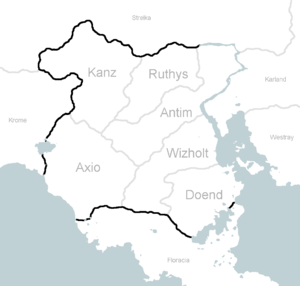
Vocavium is divided into 8 autonomous federal districts as well as 2 island Territories.
Foreign Relations
###
Demographics
Languages
###
Education
###
Religion and Culture
The people of Vocavium are hardy and austere, having learned to survive primarily in the inhospitable valleys of the Avem mountains. As such, Vocavian spirituality is heavily associated with the sky, vitality and stoicism, and religious practices are a national staple.
Attempting to scale Mt. Ataksat is something of a spiritual pilgrimage, with hundreds attempting the perilous journey each year, and many often meeting their fates. However, those that succeed are regarded as national heroes and are elevated significantly in social stature.
Whilst not strictly religious, Vocavian mythology is deeply ingrained within Vocavian society and culture. The Thunderbird is the god of the Vocavian people and is greatly revered by all. It is depicted as an enormous bird with metaphysical powers, and is believed to be the creator and custodian of the universe. The mountainous environment of Vocavium has encouraged a deeply rooted endearment with the sky, as those who have climb higher have reached closer to heaven. Whilst not overtly worshipped, the Thunderbird is generally appeased through edifying and spiritual rituals such as mountain climbing, ritual dancing, psychical combat and above all flight, whether it be powered or indeed simply free-falling. subsequently, aviation is regarded as one of the most sacred practices conceivable and is revered as such. Unfortunately, some interpretations of the mythos have lead to numerous cases of suicide, as kerbals leap from tall buildings or mountains in an effort to achieve spiritual edification through flight.
Whilst flight is the most important aspect of Vocavian culture, the presence of the K'yangtze river has given rise to a powerful maritime focus as well. An imposing naval force has been developed and maintained since the nation's inception and serves as the primary means of projecting influence. Instead, aviation serves a more ceremonial role and despite being so revered, is not in fact a focus of Vocavian military doctrine.
Age
###
Military
Air Force
The Vocavian Air Force serves to protect Vocavian airspace and project influence across the globe. Whilst Vocavians are most suited to life as a sailor, it is the shared passion of many to reach for the sky and step closer to the heavens. No role in the Vocavian military holds as much prestige and respect as that of the fighter pilot, who in the eyes of Vocavians flies closer to the sun and therefore to divinity.
Army
###
The Vocavian Navy is the branch of the military concerned with all maritime and fluvial affairs. It is the largest and most important aspect of the Vocavian Military, and is host to some of the most advanced warships afloat. Having relied on the navigation of river and ocean environments for centuries, the people of Vocavium are natural sailors and are acquitted to a naval lifestyle.
Orbcom
###
Economy
Taxation
###
Transport
###
Energy and Infrastructure
###
Trade
One of Vocavium's primary sources of funds is it's thriving export market. Vocavian shipbuilding is recognised as world-class, and as such ship orders are abundant and lucrative.
One of Vocavium's most impressive and prominent landmarks is the Thunderdome, a massive shipbuilding complex located on the south east coast. At 15km across and with an area of over 50km2, it is the largest shipyard on the planet, and has produced most of the surface vessels currently in use by the navies around the world. A system of cable cars suspended above the complex allows for fast navigation of the labyrinthine network of dry docks and factories, also offering grand views of the industrial landscape.
Science
###
History
The first people to settle Vocavium lived for centuries as nomadic tribes, divided into distinct cultural bands. Such groups often warred amongst themselves in vicious combat across the many perilous environments, chief among which were the mountains, which hold great spiritual significance to Vocavians and were host to frequent battles at the frigid peaks. Over the course of decades, such tribes sought strength through unity and settled in fixed locations, with a disparate spread across each of the biomes of the country. These were recognised as semi-independent states, until the birth and rise to prominence of Calbrett Shatter-Horn, who swiftly ascended to the role of Chieftain of the mountain clans by rite of strength. Under his rule, a hasty military campaign was launched against the tribes of the steppes with the intention of assimilating them into his own ranks, resulting in a Pyrrhic victory. With both sides severely crippled, Shatter-Horn broached the issue of a mutually beneficial alliance, leaving the tribes of the steppes no choice but to accept. Once unified, the newly formed Federation of Vocavium grew in strength, leading to the voluntary surrender and subsequent assimilation of the smaller remnant tribes occupying the southern mangroves. Within a few short years, the Federation succeeded in unifying the people of Vocavium with a common interest in military might and crucially spiritual edification, with the latter being accomplished by obtaining the former. The unification of the people saw a marked increase in economic prosperity owing to the enhanced cooperation between peoples. Such cultural and political harmony is enabled by the sense of justice and deference to the mightier authority that is central to Vocavian culture.
Notable Events
About The Flag
